
The Genoese School (Scuola genovese, in Italian) is a cultural and art movement [1] [2] [3] [4] [5] developed and rooted, since the 1960s, in Genoa, Italy. It is mainly linked to the Italian "canzone d'autore" (art song). [6] [7] [8]

The Genoese School (Scuola genovese, in Italian) is a cultural and art movement [1] [2] [3] [4] [5] developed and rooted, since the 1960s, in Genoa, Italy. It is mainly linked to the Italian "canzone d'autore" (art song). [6] [7] [8]
Among the major representatives of the "classical school" of the 1960s are: Umberto Bindi, Fabrizio De André, Bruno Lauzi, Gino Paoli, Giorgio Calabrese and Luigi Tenco. An important role was played also by the brothers Gian Franco and Gian Piero Reverberi, musicians and arrangers from Genoa who promoted many of the "cantautori" of the first generation, allowing them to work in Milan. [3] [7] [8] [9] [10] All of them were musically and artistically grown in Genoa, city where they were born or have been moved to as children. [11] They use, during the 1960s, to meet each other at the Foce di Genova and, in particular, at the dairy bar "Igea" (which was a source of inspiration to Gino Paoli for his song Quattro amici in 1991), in via Casaregis at the corner with via Cecchi (later renamed as Roby Bar and today named Mini Mixing Bar).
This movement determined «a deep break with the traditional Italian music», [7] in primis for a renewed artistic means, more refined and eclectic, and then for a diverse use of the language, more realist. Thus, facing a huge variety of themes, from sentiments, to existential experiences, to politics, to ideology, to war and themes as the social exclusion, [7] with strong individualistic accent and close to the tones of the French existentialism. [7] Cultural influences of the Genoese School are different, from the Italian and Ligurean literary and musical tradition (Camillo Sbarbaro, Cesare Pavese, Giorgio Caproni, Riccardo Mannerini [7] ), from the French and English literature of the begin of 20th century (Jean-Paul Sartre, Raymond Queneau), [6] from the anarchic philosophy (in particular Tenco, De André and Paoli [7] [12] ) and the liberal one (Lauzi [8] ), from the French music of Charles Aznavour, Jacques Brel and Georges Brassens [6] from the US-folk of Bob Dylan. [13] Amongst the literary exponents from Beat Generation: Allen Ginsberg, Jack Kerouac, William Burroughs e Gregory Corso. In particular, both Lauzi and De André dedicated part of their production to their cities, adopting also the Ligurian language in more songs; [7] examples are the songs Genova per noi (Bruno Lauzi, but written by the piemontese Paolo Conte, 1975) and Crêuza de mä (Fabrizio De André, 1984). The sea of Liguria is a recurrent topic for all the cantautori of the Genoese School. [7]
Initially defined to name the first members only, this locution become larger including more and more members over time. Members of the first generation include Vittorio De Scalzi (singer-songwriter and co-author of Fabrizio de André), the New Trolls, the Ricchi e Poveri and Matia Bazar. [3] Then, members of new generations, as Ivano Fossati and Francesco Baccini, [3] [14] [15] are followed by Max Manfredi, Federico Sirianni, [16] Cristiano De André and others. Linked to this cultural environment are also authors as Fernanda Pivano, who translated into Italian the Spoon River Anthology , book on which De André based his album Non al denaro non all'amore né al cielo , and the actor Paolo Villaggio, close friend of De André and coauthor for a couple of song of him (Carlo Martello ritorna dalla battaglia di Poitiers and Il fannullone).

In a music shop is arranged an exhibition about the Genoese School, named "Via del Campo 29 rosso". The owner, Gianni Tassio, was a friend of De André. The shop is located in Via del Campo, a typical road in the medieval center of Genoa to whom De André dedicated a song. In 2010, the city of Genoa acquired the shop and turned it into a permanent exhibition dedicated to De André and the Genoese School.

The Republic of Genoa was a medieval and early modern maritime republic from the 11th century to 1797 in Liguria on the northwestern Italian coast. During the Late Middle Ages, it was a major commercial power in both the Mediterranean Sea and the Black Sea. Between the 16th and 17th centuries, it was one of the major financial centers in Europe.

Fabrizio Cristiano De André was an Italian singer-songwriter and the most-prominent cantautore of his time. His 40-year career reflects his interests in concept albums, literature, poetry, political protest, and French music. He is considered a prominent member of the Genoese School. Because of the success of his music in Italy and its impact on the Italian collective memory, many public places such as roads, squares, and schools in Italy are named for De André.
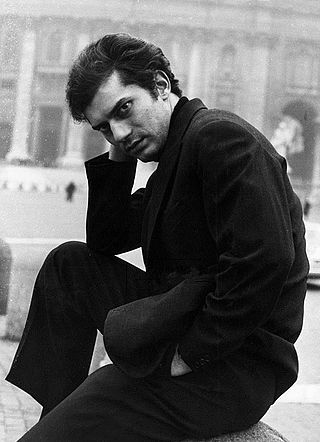
Luigi Tenco was an Italian singer-songwriter.
Genoese, locally called zeneise or zeneize[zeˈnejze], is the prestige dialect of Ligurian, spoken in and around the Italian city of Genoa, the capital of Liguria, in Northern Italy.

Sergio Endrigo was an Italian singer-songwriter.

Boccadasse is an old mariners' village of the Italian city of Genoa. It lies within the borders of the neighbourhood of Albaro. In today's administrative subdivision it is located in the Municipio VIII - Medio Levante area which includes the neighbourhoods of Albaro, Foce, San Martino. Boccadasse is bordered on the west side by Via Felice Cavallotti, by Via Caprera on the northern side and by Via Capo di Santa Chiara on the eastern side. Naturally, it is delimited by the sea to the south.

Bruno Lauzi was an Italian singer-songwriter, poet and writer.

Albaro is an affluent residential neighbourhood of the Italian city of Genoa, located 3 kilometres (1.9 mi) east of the city centre. It was formerly an independent comune, named San Francesco d'Albaro, included in the city of Genoa in 1873. At present, together with the neighbourhoods of Foce and San Martino d'Albaro is part of the Genoa's city VIII Municipio.
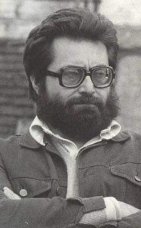
Gian Piero Reverberi is an Italian pianist, composer, arranger, conductor, and entrepreneur.

The Delle Piane family is an old Genoese noble family first recorded in Polcevera in 1121. Over the past ten centuries it has produced many distinguished government officials, clerics, diplomats, soldiers and patrons.

Genoa: Le Strade Nuove and the system of the Palazzi dei Rolli is a UNESCO World Heritage Site which includes a number of streets and palaces in the center of Genoa, in Northwestern Italy.
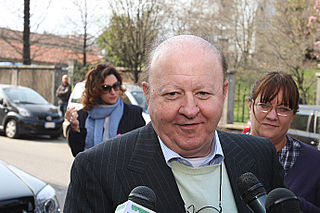
Massimo Antonio Boldi is an Italian stand-up comedian and actor.

Dischi Ricordi was an Italian record company founded on October 1, 1959 by Nanni Ricordi and Franco Crepax, active from 1958 to 1994.
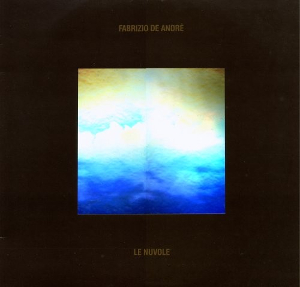
Le nuvole is an album by Italian singer-songwriter Fabrizio De André, released in 1990. The songs were written by Fabrizio De André and Mauro Pagani. As Pagani revealed in an interview within the 2011 DVD biographical documentary series Dentro Faber, he is responsible for the writing of most of the music, while De André wrote all of the lyrics – except for Don Raffaè, detailed below, whose lyric writing is shared between De André and singer-songwriter Massimo Bubola, and the lyrics to the two songs in Genoese on side B, "Mégu megún" and "'Â çímma", which De André co-wrote with fellow Genoan Ivano Fossati because, according to De André, his colleague's ability to play with the sounds and the inner melodies of the Genoese dialect was much better than his own. Pagani's collaboration with De André, always according to the Lombard musician, happened in an identical way for De André's previous album, Crêuza de mä, with Pagani setting to music De André's already fully written lyrics, on the basis of a few melodic ideas from the latter. His next songwriting collaboration with Fossati, on Anime salve, would be more equally balanced, with he and Fossati composing music by actually playing together.

The Genoesecolonies were a series of economic and trade posts in the Mediterranean and Black Seas. Some of them had been established directly under the patronage of the republican authorities to support the economy of the local merchants, while others originated as feudal possessions of Genoese nobles, or had been founded by powerful private institutions, such as the Bank of Saint George.

Genoa is a city in and the capital of the Italian region of Liguria, and the sixth-largest city in Italy. In 2023, 558,745 people lived within the city's administrative limits. While its metropolitan area has 813,626 inhabitants. Over 1.5 million people live in the wider metropolitan area stretching along the Italian Riviera.
Giovine Orchestra Genovese is an Italian music organization, concert society and cultural association, founded in 1912 in Genoa by Giovanni Semeria. A nonprofit organization, it organizes and produces classical and chamber music concerts and promotes musical education for students.
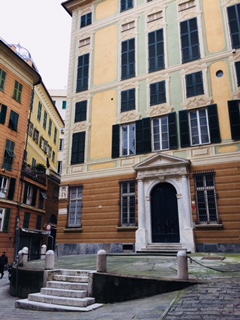
The Palazzo Clemente della Rovere is a palace located in Piazza Rovere in the historical center of Genoa, Northwestern Italy. The palace was one of the 163 Palazzi dei Rolli of Genoa, the selected private residences where the notable guests of the Republic of Genoa were hosted during State visits. On 13 luglio 2006 it was added to the list of 42 palaces which now form the UNESCO World Heritage Site Genoa: Le Strade Nuove and the system of the Palazzi dei Rolli. The palace hosts today the General Consulate of Iceland.